Perhaps you’re thinking—basis the title—she’s gone too far this time. What does she mean we were created to BE Priests?
You don’t have to take my word for it. It’s in the Bible…from the beginning to the end.
In Genesis, Adam and Eve were to work the Garden and take care of it. This is the Lord’s sanctuary; and Adam’s and Eve’s combined act of worship was their serving God by taking care of the place where God met with them. In the Garden of Eden, Adam and Eve were priests.
A stretch, you think? Well, take a look at this one:
Then Moses went up to God, and the LORD called to him from the mountain and said, “This is what you are to say to the house of Jacob and what you are to tell the people of Israel: ‘You yourselves have seen what I did to Egypt, and how I carried you on eagles’ wings and brought you to myself. Now if you obey me fully and keep my covenant, then out of all nations you will be my treasured possession. Although the whole earth is mine, you will be for me a kingdom of priests and a holy nation.’ These are the words you are to speak to the Israelites.” So Moses went back and summoned the elders of the people and set before them all the words the LORD had commanded him to speak. The people all responded together, “We will do everything the LORD has said.” So Moses brought their answer back to the LORD. (Exodus 19:3-8)
When we obey God fully and keep His covenant, we are His treasured possession, a kingdom of priests, and a holy nation. Maybe you’re thinking, “Hmmm. That was the Old Testament and it’s talking about Israel, not Christians.” Alright, how about this next one?
Therefore, I urge you, brothers, in view of God’s mercy, to offer your bodies as living sacrifices, holy and pleasing to God– this is your spiritual act of worship. (Romans 12:1)
 Offering sacrifices to God as a spiritual act of worship: Isn’t that the function of a priest in Old Testament language here in the New Testament? Doesn’t Scripture say that our bodies are the Temple of God (1 Corinthians 3:16)? By His Spirit dwelling in us, aren’t our bodies the place where God meets with us? If yes and Amen and Amen, then doesn’t it follow that when we serve God with our bodies as a spiritual act of worship, we are performing the function of a priest?
Offering sacrifices to God as a spiritual act of worship: Isn’t that the function of a priest in Old Testament language here in the New Testament? Doesn’t Scripture say that our bodies are the Temple of God (1 Corinthians 3:16)? By His Spirit dwelling in us, aren’t our bodies the place where God meets with us? If yes and Amen and Amen, then doesn’t it follow that when we serve God with our bodies as a spiritual act of worship, we are performing the function of a priest?
Many of us find the concept of BE-ing a priest unsettling. When I was in high school, the last thing anyone—including me—would have thought was that I’d become SeminaryGal. Serving God? Theologically driven? Priest? The chuckle would have blossomed into a full belly laugh from all of us.
 I remember two instances in which the concept of pastor/priest hit home. The first one was when I was speaking with an individual who held a significant administration position in our community. He is Jewish and when he heard that I was in seminary, he asked if when I got out, I’d end up wearing one of those little white collars. We both laughed at the thought and I said that my denomination of church doesn’t do the little white collars…for that matter, women don’t do that kind of service. Then he asked, “Why go through with it then?” I responded, “I really don’t know. I guess, just because God is sending me.” Later on I thought, it doesn’t have to make sense to me. It’s not my role to pass judgment on God’s commission. My role is to do it.
I remember two instances in which the concept of pastor/priest hit home. The first one was when I was speaking with an individual who held a significant administration position in our community. He is Jewish and when he heard that I was in seminary, he asked if when I got out, I’d end up wearing one of those little white collars. We both laughed at the thought and I said that my denomination of church doesn’t do the little white collars…for that matter, women don’t do that kind of service. Then he asked, “Why go through with it then?” I responded, “I really don’t know. I guess, just because God is sending me.” Later on I thought, it doesn’t have to make sense to me. It’s not my role to pass judgment on God’s commission. My role is to do it.
The other time was when I was driving for two days with my daughter, we were going to Florida for a working vacation. When we got there, one of her friends phoned and howling with laughter, asked her, “So how was it going on a road trip with The Paaaaaasterrrrrrrr?” I asked my daughter, “I’m still OK, right? It wasn’t all that bad…was it?”
BE-ing a priest doesn’t mean donning a white color or becoming humanity’s wet blanket, smothering out any semblance of humor or fun. It does mean recognizing that stereotypes will hound the person who is seeking to serve God all the time—our being that living sacrifice. Jokes persist about white collars and being a Holy Roller, Bible thumper, religious Zealot, or right-wing fanatic. But the person—male or female—truly serving God wholeheartedly doesn’t need to be ashamed of BE-ing a priest. It witnesses in wonderful ways a person would never anticipate.
We can withstand the ridicule because all Christians someday will embrace the role—regardless of race or gender. As surely as Jesus stands as King, we will all serve as priests.
And they sang a new song: “You are worthy to take the scroll and to open its seals, because you were slain, and with your blood you purchased men for God from every tribe and language and people and nation. You have made them to be a kingdom and priests to serve our God, and they will reign on the earth.” Revelation 5:9-10
We were Created to BE Priests.
 NIV Genesis 15:1 After this, the word of the LORD came to Abram in a vision: “Do not be afraid, Abram. I am your shield, your very great reward.” 2 But Abram said, “O Sovereign LORD, what can you give me since I remain childless and the one who will inherit my estate is Eliezer of Damascus?” 3 And Abram said, “You have given me no children; so a servant in my household will be my heir.” 4 Then the word of the LORD came to him: “This man will not be your heir, but a son coming from your own body will be your heir.” 5 He took him outside and said, “Look up at the heavens and count the stars– if indeed you can count them.” Then he said to him, “So shall your offspring be.” 6 Abram believed the LORD, and he credited it to him as righteousness.
NIV Genesis 15:1 After this, the word of the LORD came to Abram in a vision: “Do not be afraid, Abram. I am your shield, your very great reward.” 2 But Abram said, “O Sovereign LORD, what can you give me since I remain childless and the one who will inherit my estate is Eliezer of Damascus?” 3 And Abram said, “You have given me no children; so a servant in my household will be my heir.” 4 Then the word of the LORD came to him: “This man will not be your heir, but a son coming from your own body will be your heir.” 5 He took him outside and said, “Look up at the heavens and count the stars– if indeed you can count them.” Then he said to him, “So shall your offspring be.” 6 Abram believed the LORD, and he credited it to him as righteousness. Our worship in song and Scripture will be unified by this theme of hope and deliverance. Each week, we will have the privilege of hearing from different volunteers from area churches representing different Christian denominations. We hope to give patients, visitors, and the staff at the hospital a taste of various worship expressions ongoing at area churches in addition to opportunities for being encouraged by the Gospel each week.
Our worship in song and Scripture will be unified by this theme of hope and deliverance. Each week, we will have the privilege of hearing from different volunteers from area churches representing different Christian denominations. We hope to give patients, visitors, and the staff at the hospital a taste of various worship expressions ongoing at area churches in addition to opportunities for being encouraged by the Gospel each week.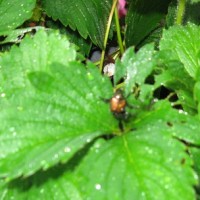 Japanese Beetles (right) are veritable eating machines, able to decimate entire plants, crops, and gardens. We’re in the height of Japanese Beetle season at present and there are ways of keeping them under control.
Japanese Beetles (right) are veritable eating machines, able to decimate entire plants, crops, and gardens. We’re in the height of Japanese Beetle season at present and there are ways of keeping them under control.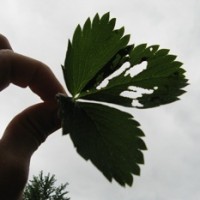 I do spray, but only when truly necessary—when things have gotten totally out of hand as they did one year that a bazillion of them were hanging out in a nearby linden tree, skeletonizing all the leaves (see damage to strawberry leaf at left). I’m not a big fan of spraying chemicals because they’re generally indiscriminate, killing friend and foe with equal force. Anything I can do to be more selective and less harmful, the better.
I do spray, but only when truly necessary—when things have gotten totally out of hand as they did one year that a bazillion of them were hanging out in a nearby linden tree, skeletonizing all the leaves (see damage to strawberry leaf at left). I’m not a big fan of spraying chemicals because they’re generally indiscriminate, killing friend and foe with equal force. Anything I can do to be more selective and less harmful, the better.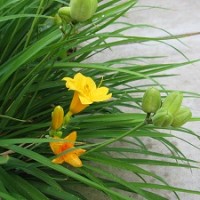 Of the frequently asked questions I received on the sales floor, people asked how to care for their daylilies. They’d bubble with excitement at seeing a big daylily that looked like this (right).
Of the frequently asked questions I received on the sales floor, people asked how to care for their daylilies. They’d bubble with excitement at seeing a big daylily that looked like this (right). 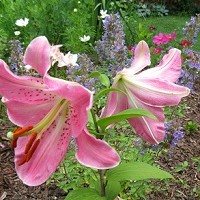 Plants have a legal name, if you will, that consists of a genus (larger group) and species (subgroup). Beyond that, certain cultivated varieties (cultivars for short) will have a name in quotes which makes it even more specific. The Oriental lily Lilium ‘Farolito’ shown here is a cultivar. Lilium x ‘Kiss Me Kate’ would be a hybrid lily denoted by an ‘x’ to show that it is a cross between a longiflorum lily (like an Easter lily) and an Asiatic lily.
Plants have a legal name, if you will, that consists of a genus (larger group) and species (subgroup). Beyond that, certain cultivated varieties (cultivars for short) will have a name in quotes which makes it even more specific. The Oriental lily Lilium ‘Farolito’ shown here is a cultivar. Lilium x ‘Kiss Me Kate’ would be a hybrid lily denoted by an ‘x’ to show that it is a cross between a longiflorum lily (like an Easter lily) and an Asiatic lily.
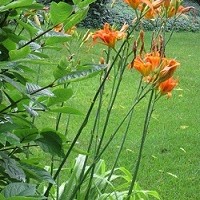 They grow differently in form—lilies (pictured on the left) are flowers emerging atop leafy stalks, daylilies (right) form clumps. They originate from different structures—lilies arise from bulbs, daylilies grow from fibrous root systems that will enlarge into spindle-like roots resembling tubers. Lily flowers are long lasting and open from the lower buds to the upper buds. When the buds have all opened, the flowering is completed for the year. Daylilies, on the other hand, have a short bloom—each lasting only a day, hence daylily, however the season of bloom may be quite extensive. Lily bulbs must be planted at a sufficient depth to protect them from the harsh winters, but not so deep that the plant must struggle through an endless stretch to reach the soil surface. Daylilies are planted so the crown is at the soil level with the fibrous roots and tuberous spindles are stretched out just below the soil surface. Lilies will grow larger clumps by growing increasing bulb sizes as well as by dropping bulbils (present after bloom in the leaf axils) off the stem onto the ground. Daylilies, depending on variety, can be downright invasive…emerging anywhere there’s an opportunity within the range of the mother plant.
They grow differently in form—lilies (pictured on the left) are flowers emerging atop leafy stalks, daylilies (right) form clumps. They originate from different structures—lilies arise from bulbs, daylilies grow from fibrous root systems that will enlarge into spindle-like roots resembling tubers. Lily flowers are long lasting and open from the lower buds to the upper buds. When the buds have all opened, the flowering is completed for the year. Daylilies, on the other hand, have a short bloom—each lasting only a day, hence daylily, however the season of bloom may be quite extensive. Lily bulbs must be planted at a sufficient depth to protect them from the harsh winters, but not so deep that the plant must struggle through an endless stretch to reach the soil surface. Daylilies are planted so the crown is at the soil level with the fibrous roots and tuberous spindles are stretched out just below the soil surface. Lilies will grow larger clumps by growing increasing bulb sizes as well as by dropping bulbils (present after bloom in the leaf axils) off the stem onto the ground. Daylilies, depending on variety, can be downright invasive…emerging anywhere there’s an opportunity within the range of the mother plant. Offering sacrifices to God as a spiritual act of worship: Isn’t that the function of a priest in Old Testament language here in the New Testament? Doesn’t Scripture say that our bodies are the Temple of God (1 Corinthians 3:16)? By His Spirit dwelling in us, aren’t our bodies the place where God meets with us? If yes and Amen and Amen, then doesn’t it follow that when we serve God with our bodies as a spiritual act of worship, we are performing the function of a priest?
Offering sacrifices to God as a spiritual act of worship: Isn’t that the function of a priest in Old Testament language here in the New Testament? Doesn’t Scripture say that our bodies are the Temple of God (1 Corinthians 3:16)? By His Spirit dwelling in us, aren’t our bodies the place where God meets with us? If yes and Amen and Amen, then doesn’t it follow that when we serve God with our bodies as a spiritual act of worship, we are performing the function of a priest? I remember two instances in which the concept of pastor/priest hit home. The first one was when I was speaking with an individual who held a significant administration position in our community. He is Jewish and when he heard that I was in seminary, he asked if when I got out, I’d end up wearing one of those little white collars. We both laughed at the thought and I said that my denomination of church doesn’t do the little white collars…for that matter, women don’t do that kind of service. Then he asked, “Why go through with it then?” I responded, “I really don’t know. I guess, just because God is sending me.” Later on I thought, it doesn’t have to make sense to me. It’s not my role to pass judgment on God’s commission. My role is to do it.
I remember two instances in which the concept of pastor/priest hit home. The first one was when I was speaking with an individual who held a significant administration position in our community. He is Jewish and when he heard that I was in seminary, he asked if when I got out, I’d end up wearing one of those little white collars. We both laughed at the thought and I said that my denomination of church doesn’t do the little white collars…for that matter, women don’t do that kind of service. Then he asked, “Why go through with it then?” I responded, “I really don’t know. I guess, just because God is sending me.” Later on I thought, it doesn’t have to make sense to me. It’s not my role to pass judgment on God’s commission. My role is to do it.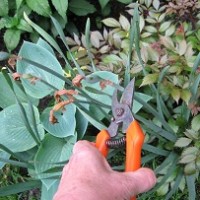
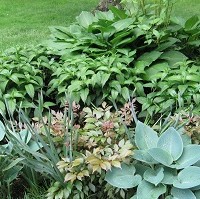 Pictured here are two instances of daffodil inter-planting. In the wet area of my yard, the hostas, astilbe, turtlehead have emerged and I can tuck the foliage behind these companion plants until it has completely died back. The foliage will continue to make food with plenty of sunlight and grow the bulk of the bulbs, then the summer perennials will fill the space left behind as the daffodils recede.
Pictured here are two instances of daffodil inter-planting. In the wet area of my yard, the hostas, astilbe, turtlehead have emerged and I can tuck the foliage behind these companion plants until it has completely died back. The foliage will continue to make food with plenty of sunlight and grow the bulk of the bulbs, then the summer perennials will fill the space left behind as the daffodils recede.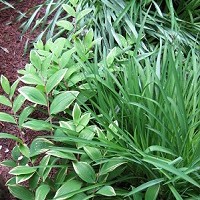
 Since a container garden must share the same watering requirement and light level, taking care to select compatible companions is helpful. Consider these hanging baskets I made from two window boxes back to back. They are hung from their back loops by using chain link (painted with craft paint to reduce its sheen). The back window box has maidenhair fern, ivy, fittonia, and nepthytis and the front window box has creeping jenny/moneywort, coleus, tuberous begonia, and impatiens. Since I will never rotate these, the front box will get brighter light and the back box will be even more shaded and moist. I like the stewardship present as well since the maidenhair fern, ivy, fittonia and nepthytis are all houseplants that I’m summering outdoors and the creeping jenny was recycled from early spring pots. I enjoy creating beautiful things primarily from what I already have on hand, plus an added item or two. Beauty from season to season!
Since a container garden must share the same watering requirement and light level, taking care to select compatible companions is helpful. Consider these hanging baskets I made from two window boxes back to back. They are hung from their back loops by using chain link (painted with craft paint to reduce its sheen). The back window box has maidenhair fern, ivy, fittonia, and nepthytis and the front window box has creeping jenny/moneywort, coleus, tuberous begonia, and impatiens. Since I will never rotate these, the front box will get brighter light and the back box will be even more shaded and moist. I like the stewardship present as well since the maidenhair fern, ivy, fittonia and nepthytis are all houseplants that I’m summering outdoors and the creeping jenny was recycled from early spring pots. I enjoy creating beautiful things primarily from what I already have on hand, plus an added item or two. Beauty from season to season!